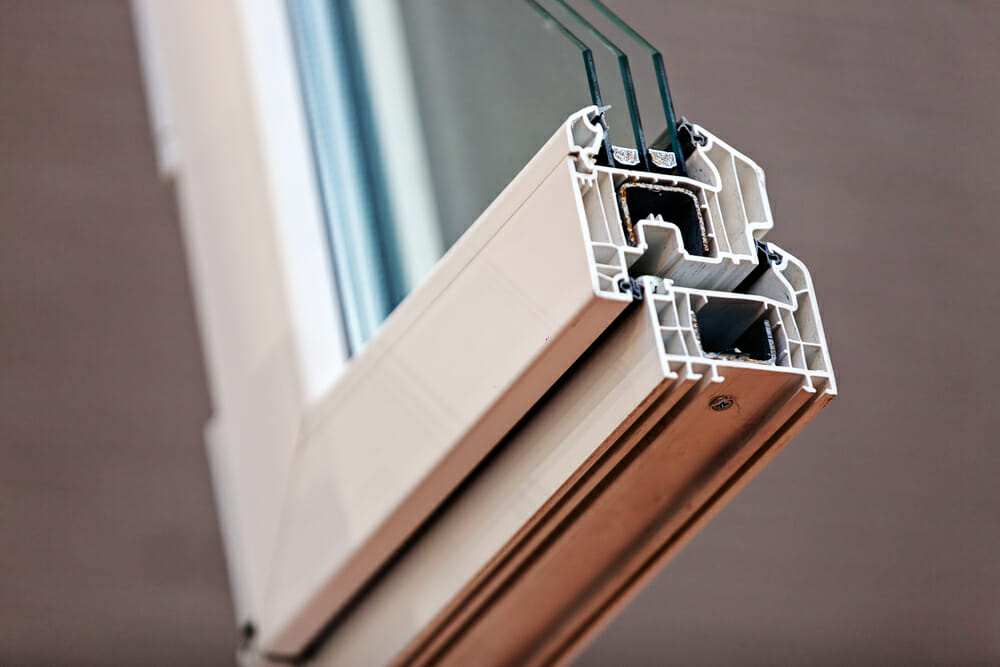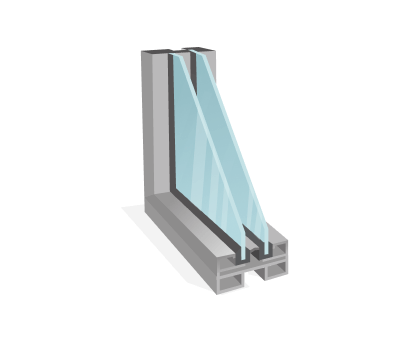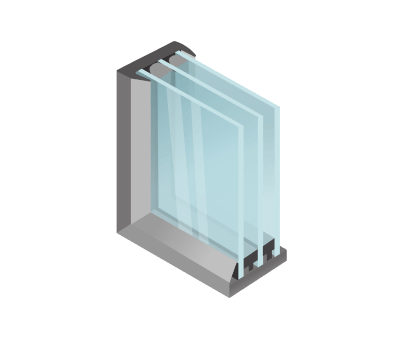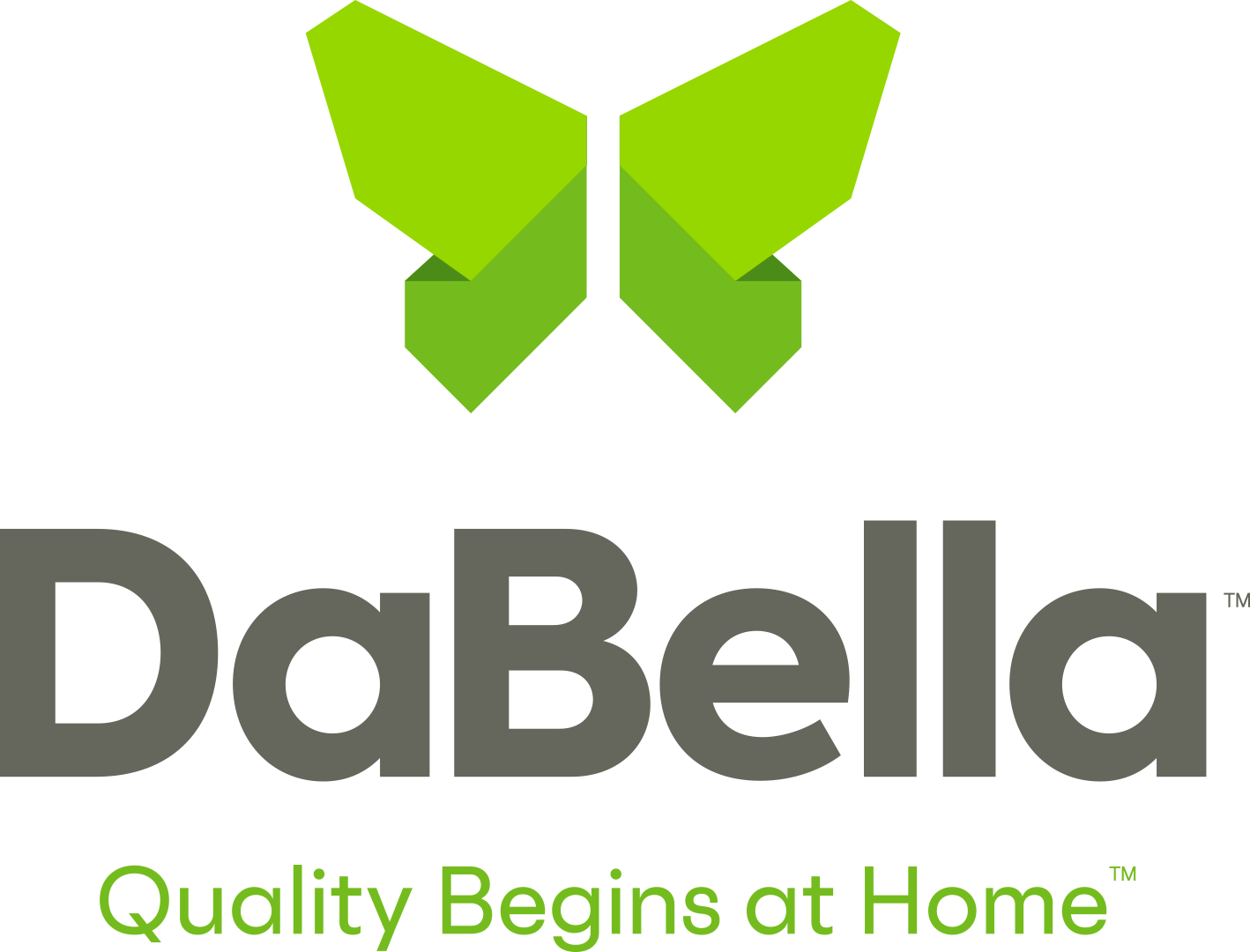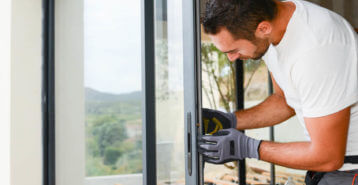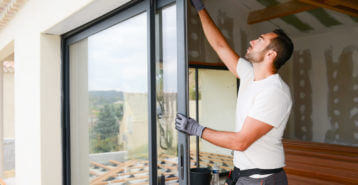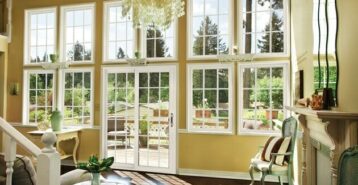Energy Efficient Windows Cost
An energy efficient window with an Energy Star rating will cost between $473 to $3,109 per window. That’s a wide cost range! The type of window you choose, what size it is, if you need double- or triple-paned glass with any efficiency upgrades like a low-E coating or a gas fill, and what kind of frame material you choose will all impact where in that price range your own project falls.
Before we break down each of these cost factors, let’s first talk briefly about what an energy efficient window is and why you might want to choose one.
What Are Energy Efficient Windows?
Energy efficient windows are designed to keep heat and/or air conditioning in while keeping outside temperatures out. Most homeowners are interested in energy efficient windows because they keep home temperatures more comfortable as well as reduce utility bills. That’s because if your windows are doing a good job at keeping the outside temps from impacting the inside temps, you need to run your HVAC system less.
Factors Impacting the Cost of Energy Efficient Windows
Your window replacement cost for an energy efficient unit will vary depending on the following:
- Size. A large window with several moving parts and/or a lot of glass will of course cost more than a smaller window.
- Type. A double-hung window will cost more than a single-hung window, but both will be cheaper than a bay window.
- Frame material. Vinyl frames are the least expensive while high-end materials like clad wood or fiberglass can cost quite a bit more.
- Double-pane vs triple-pane. If you live in an area with extreme temperatures – particularly in the winter – then you may need triple-pane windows. Those cost more than double-pane windows.
- Glass efficiency upgrades. Adding a low-E coating, gas fill, or other elements to your window glass that will make it even more energy efficient will increase the price.
Let’s look at each of these factors individually so you can better estimate your own project cost.
Cost by Size
If you’re replacing your window with a new one that is the same size, then measuring your existing window is the best way to find out what size you need. You can check out our guide on how to measure windows for more information.
However, if you aren’t sure what size window you want or just want to estimate without getting out the tape measure, then be aware that different window types come in different standard sizes.
For the purposes of estimating cost, we chose small, medium, and large measurements that exist across multiple window types.
| Window Size | Average Cost Range |
|---|---|
| Small (around 24"x36") | $150 - $350 |
| Medium (around 36"x48") | $250 - $500 |
| Large (around 48"x60") | $350 - $750 |
To learn more about standard window sizes, you can read our guide.
Cost by Type
There are more than 20 window types, but we’ve chosen six of the most popular windows in the U.S. for the table below.
| Window Type | Average Cost Range |
|---|---|
| Single-Hung | $200 - $450 |
| Double-Hung | $300 - $600 |
| Awning | $300 - $550 |
| Sliding | $350 - $700 |
| Casement | $350 - $750 |
| Picture | $250 - $650 |
Aren’t sure which window type you have? Here’s a cheat sheet:
- Single-hung: Only the bottom sash moves vertically.
- Double-hung: Both the upper and lower sashes can move.
- Awning: Hinged at the top and open outward.
- Sliding: One or more panels move horizontally.
- Casement: Hinged at the side to swing outward.
- Picture: Fixed, does not open.
If you still aren’t sure or don’t know what type you want to replace it with, you can take our quiz or read about all 20 types over at our page about types of windows.
Cost by Frame
There are five main frame materials to choose from, and each has a different energy efficiency capacity. Here’s how energy efficient window frame costs break down:
| Frame Type | Average Cost Range |
|---|---|
| Vinyl | $200 - $600 |
| Aluminum | $300 - $700 |
| Clad Wood | $400 - $900 |
| Wood | $300 - $800 |
| Fiberglass | $500 - $1,000 |
If you’re not familiar with frame materials, here’s what to know in brief:
- Vinyl: Popular due to its cost-effectiveness and low maintenance. Comes in a range of energy efficient options, including an insulated version.
- Aluminum: Durable, light, and modern, but less energy efficient. It conducts heat well, making it the least desirable option for a home where energy efficiency is needed.
- Clad wood: Wood interior with an exterior aluminum or vinyl shell. This is one way to get the look of aluminum with the efficiency of wood.
- Wood: Offers a classic appearance but requires more maintenance. Wood is an excellent insulator, making this a good choice for energy-efficiency.
- Fiberglass: Durable and extremely energy efficient, but more expensive than the other options.
However, we do not recommend choosing a frame material based on energy efficiency alone. A wood window frame, for example, has excellent insulating qualities, but it requires a lot of maintenance and upkeep, especially in wetter climates.
To find the frame material that will meet your energy efficiency needs and will also work best for your home’s look and your desired maintenance requirements, you can visit our guide to window frame types.
Double- vs Triple-Pane Cost
As a general rule, triple-pane windows are more energy efficient than double-pane windows. But that doesn’t mean triple-pane is worth the cost in every area or for every home.
We recommend you choose double-pane windows if you live in a more moderate climate and/or are looking for improved energy efficiency.
You should choose triple-pane windows if you live in an area with harsh weather conditions and/or want the maximum energy savings possible.
You can read more about double-pane window costs or triple-pane window costs by visiting our cost guides.
Glass Upgrades
In addition to window type, number of panes, and frame type, you can also upgrade the glass for additional energy efficiency. Here are two popular options:
- Low-E coating. This gets applied to the glass and helps to keep heat in your home during the winter while reflecting it back out during the summer. It blocks UV rays. Low-E glass can add $150 to $300 per window. You can learn more about low-E glass over at our guide.
- Gas fillings. The space between panes of glass can be filled with argon, krypton, or xenon gas. Our blog post on the best gas insulated windows can tell you more. Gas-filled glass can add $200 to $350 per window.
Check out our guide to glass types for more information.
What Are the Most Energy Efficient Windows?
If you want the most energy efficient windows possible, you should choose triple-pane glass with a gas fill and/or low-E coating, a highly insulated frame material like composite wood or high-quality vinyl, and a window type like casement (which forms a very firm seal when closed) or picture (which does not open and close and so is not prone to air leaks or gaps).
However, that combination is not in everyone’s budget. It’s also not right for every climate or home! For example, as we noted above triple-pane windows are ideal for homes where the climate is very cold, but areas with shorter winters or milder temperatures won’t get the full benefit of triple-pane glass. Double-pane glass may serve those homes better.
Talk to a window professional to see what glass, frame, and window type is best for your area.
Other Energy Efficient Qualities to Consider
As you’ve likely noticed just by reading this guide, there is no such thing as one single energy efficient window. There are many factors to consider as you choose the right window for your home. We recommend you also explore the following:
- Energy Star windows. To learn more about which windows are given this title (and thus are eligible for several rebates and incentives), you can read our guide to Energy Star windows. You’ll find that Energy Star windows prices are very close to the costs found on this page.
- Insulated glass. Though we discussed (and recommended) gas-filled glass and low-E glass above, there are other glass qualities you could consider. Instead of gas, for example, you could fill air into the panes between your windows. You could also choose a tinted glass or even reflective glass. Read our guide to insulated glass to explore all your options.
- Thermal windows. Thermal windows are better at keeping heat out during the summer and in during the winter. They’re a good choice for homeowners who see both temperature extremes, and many energy efficient windows also qualify as thermal windows. Read our guide to thermal windows to learn more about them.
- Window brands. In addition to impacting your project cost, the window brand you choose can also play a role in how energy efficient your window ultimately is. Explore our guide to the best window brands to read our recommendations.
How to Find Savings
You can save money on your energy efficient windows by taking advantage of rebates, incentives, and tax credits. Try the following to start:
- Visit the Energy Star windows and skylights page and use their climate zone finder to determine which windows are eligible for tax credits.
- Explore DSIRE’s database of state incentives for renewables and efficiency to see if your state offers any local incentives.
- If you are upgrading more than just your windows, you may also want to explore Energy Star’s page on federal tax credits for homeowners so you can maximize your savings for both this project as well as any others you may start.
- As always with window replacement projects, shopping during the off-season (winter in most areas) and buying three or more windows at once can save you money.
Are They Worth It?
Over time, you will earn back what you spend on energy efficient windows — and more. How quickly you earn back your out-of-pocket expenses will depend on what windows you currently have.
Energy Star notes that you can expect to save $125 to $340 per year if you are replacing single-pane windows. If you are replacing double-pane windows with clear glass, you can save $20 to $70 per year with energy efficient windows. How much you’ll save depends on where you live. You can explore their guide to window costs and energy savings to learn more.
The Final Word on Energy Efficient Windows
Just about every homeowner can benefit from energy efficient windows. However, the choice between double-pane and triple-pane along with frame material and other glass upgrades depends on the climate your home is in as well as your budget.
You can explore everything related to home window replacement over at our project page, or if you’re ready for quotes, you can check out our contractor directory to see pros in your area.
We recommend getting three to four quotes to find the best price for your project. If you’d like Modernize to take the legwork out of that process, click below and answer a few questions about your project and we’ll match you with up to four window pros.
Compare top-rated windows pros in your area.
Read real homeowner reviews, explore qualifications, and view promotions. Modernize makes it easy to browse professionals and find one that will be perfect for your project.

